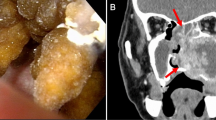Abstract
Craniopharyngiomas are intracranial tumors that usually arise in the site around the sella turcica. They are composed of distinctive sheets of epithelial cells showing adamantinomatous or squamous-papillary histologic type. Because little is known about the tumorigenesis of cranio-pharyngiomas, we retrieved samples from 15 tumor cases to investigate the functional significance of the p53 family of transcription factors, which are known to be expressed in various human epithelia. Immunohistochemical analysis of these cases demonstrated similar expression profiles of p53 family members in the two histologic types of the tumor; i.e., strong nuclear expression of p63 was observed in all cell layers, and moderate to intense nuclear expression of p73 was observed in the basal cell layers. In contrast to p63 and p73, the reactivity of an archetypal tumor suppressor, p53, was occasional and weak in the two histologic types. Because p63 was widely expressed in the tumors, reverse transcription-polymerase chain reaction (RT-PCR) analysis was conducted to elucidate which spliced variant of p63 was expressed. The results showed that †Np63, lacking a terminal transactivation domain of p63, was the dominant isoform. Together with the reported evidence that the †Np63 isoform is highly expressed in human squamous-cell carcinomas, these data suggest that the cellular architecture characteristic of the expression of p53 family members may be required for the histogenesis of craniopharyngiomas, where †Np63 has a possible role in maintaining proliferative activity of the tumor cells, like squamous-cell carcinomas in other tissues.
Similar content being viewed by others
References
Janzer RC, Burger PC, Giangaspero F, et al (2000) Craniopharyngioma. In: Kleihuse P, Cavenee WK (eds) Pathology and genetics, Tumor of the nervous system. IRAC, Lyon, pp 244–246
Xin W, Rubin MA, McKeever PE (2002) Differential expression of cytokeratins 8 and 20 distinguishes cranipharyngioma from Rathke cleft cyst. Arch Pathol Lab Med 126:1174–1178
Sekine S, Shibata T, Kokubu A, et al (2002) Craniopharyngiomas of adamantinomatous type harbor beta-catenin gene mutations. Am J Pathol 161:1997–2001
Lefranc F, Chevalier C, Vinchon M, et al (2003) Characterization of the levels of expression of retinoic acid receptors, galectin-3, macrophage migration inhibiting factor, and p53 in 51 adamantinomatous craniopharyngiomas. J Neurosurg 98:145–153
Rienstein S, Adams EF, Pilzer D, et al (2003) Comparative genomic hybridization analysis of craniopharyngiomas. J Neurosurg 98:162–164
Rickert CH, Paulus W, (2003) Lack of chromosomal imbalances in adamantinomatous and papillary craniopharyngiomas. J Neurol Neurosurg Psychiatry 74:260–261
Yang A, Kaghad M, Wang Y, et al (1998) p63, a p53 homolog at 3q27-29, encodes multiple products with transactivating, death-inducing, and dominant-negative activities. Mol Cell 2:305–316
Kaghad M, Bonnet H, Yang A, et al (1997) Monoallelically expressed gene related to p53 at 1p36, a region frequently deleted in neuroblastoma and other human cancers. Cell 90:809–819
Lee LA, Walsh P, Prater CA, et al (1999) Characterization of an autoantigen associated with chronic ulcerative stomatitis: the CUSP autoantigen is a member of the p53 family. J Invest Dermatol 113:146–151
De Laurenzi V, Rossi A, Terrinoni A, et al (2000) p63 and p73 transactivate differentiation gene promoters in human keratinocytes. Biochem Biophys Res Commun 273:342–346
Di Como CJ, Urist MJ, Babayan I, et al (2002) p63 expression profiles in human normal and tumor, tissues. Clin Cancer Res 8:494–501
Ichimiya S, Kojima T, Momota H, et al (2002) p73 is expressed in human thymic epithelial cells. J Histochem Cytochem 50:455–462
van Bokhoven H, Brunner HG (2002) Splitting p63. Am J Hum Genet 71:1–13
Yang A, Kaghad M, Caput D, et al (2002) On the shoulders of giants: p63, p73 and the rise of p53. Trends Genet 18:90–95
Benard J, Douc-Rasy S, Ahomadegbe JC (2003) TP53 family members and human cancers. Hum Mutat 21:182–191
Yang A, Kaghad M, Wang Y, et al (1998) p63, a p53 homolog at 3q27-29, encodes multiple products with transactivating, death-inducing, and dominant-negative activities. Mol Cell 2:305–316
Yang A, Walker N, Bronson R, et al (2000) p73-deficient mice have neurological, pheromonal and inflammatory defects but lack spontaneous tumours. Nature 404:99–103
Pozniak CD, Radinovic S, Yang A, et al (2000) An anti-apoptotic role for the p53 family member, p73, during developmental neuron death. Science 289:304–306
Liefer KM, Koster MI, Wang XJ, et al (2000) Down-regulation of p63 is required for epidermal UV-B-induced apoptosis. Cancer Res 60:4016–4020
Hu H, Xia SH, Li AD, et al (2002) Elevated, expression of p63 protein in human esophageal squamous cell carcinomas. Int J Cancer 102:580–583
Hibi K, Trink B, Patturajan M, et al (2000) AIS is an oncogene amplified in squamous cell carcinoma. Proc Natl Acad Sci USA 97:5462–5467
Suliman Y, Opitz OG, Avadhani A, et al (2001) p63 expression is associated with p53 loss in oral-esophageal epithelia of p53-deficient mice. Cancer Res 61:6467–6473
Stiewe T, Putzer BM (2002) Role of p73 in malignancy: tumor suppressor or oncogene? Cell Death Differ 9:237–245
Author information
Authors and Affiliations
Corresponding author
Rights and permissions
About this article
Cite this article
Momota, H., Ichimiya, S., Ikeda, T. et al. Immunohistochemical analysis of the p53 family members in human craniopharyngiomas. Brain Tumor Pathol 20, 73–77 (2003). https://doi.org/10.1007/BF02483450
Received:
Accepted:
Issue Date:
DOI: https://doi.org/10.1007/BF02483450




